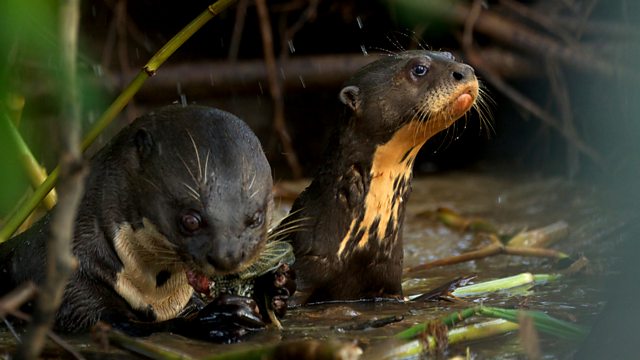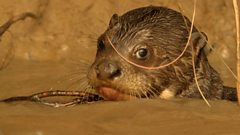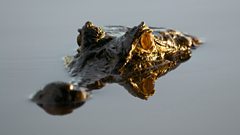
Facing the Flood
Nature documentary series. The capuchin monkey, giant otter and coati families are put to the test by Brazil's monsoon rains and floods.
This intimate journey to the heart of a Brazil continues, following the animal families as they face the formidable monsoon rains.
The giant otter babies must watch out for predatory jaguars and learn to swim before their river floods. The coatis must eat all they can before their world disappears underwater, and the youngest capuchin monkey has to learn some clever survival skills fast.
Last on
More episodes
Previous
Next
Clips
-
![]()
Culinary capuchins
Duration: 01:58
-
![]()
Lungfish lunch
Duration: 01:29
-
![]()
First swim
Duration: 02:06
-
![]()
Lethal light show
Duration: 01:35
Flooded flower meadows

Some events cannot be planned for in filmmaking but on occasion, if you’re lucky, your timing is spot on. Filming the wet-season flood in the southern Pantanal the Wild Brazil team happened upon a mesmerising spectacle that lasted just two days, and then was gone.
In one small corner of the ‘vasante’ we found a flooded meadow in full bloom. A shimmering mass of yellow and blue flowers spread out as far as the eye could see, like a brightly coloured quilt laid on top of the flood waters. Here and there a caiman’s head appeared, and small fish swarmed though channels in the forest of underwater roots.
The once-dry meadow had come to life with the recent monsoon rains. Capturing such unexpected moments was our reward for spending months in the field, waiting patiently for seasons that could never be exactly predicted. It took just the right amount of rain, followed by just enough days of sun, to bring these flowers briefly into bloom. The insects were ready to profit from their open petals, and, for once, a film crew was too!
Timing the glow

������������’s is peppered with strange earth mounds, some of them six feet tall. Built by colonies, they are home to a menagerie of wildlife and for just a few nights each year are transformed into one of ������������’s most magical natural spectacles.
In certain areas of the cerrado, each mound becomes covered in hundreds of tiny, brilliant, bright lights glowing on and off against the night sky.
This shows us not only the range of life in these mounds, but how it responds to ������������’s distinctive seasons. The glow heralds the arrival of the monsoon rains and the bringing of new life to the parched grasslands. The first rains are a cue for the termites to take to the wing to breed. And the flying termites are a cue to the glowing beetle grubs that there is food to be had. The beetles migrate through tiny tunnels to the surface of the mounds where their night-time lights attract the termites.
Lured to the tunnel entrances the termites are quickly dragged inside and stockpiled by the beetles as food for the coming wet season.
Catching these fascinating but fleeting natural events is a challenge, especially in a country the size of Brazil. We had a strong network of people on the ground who could alert us when such moments were imminent. With news of the very first glow we raced across the country – a mere 1,500 kilometres from the previous filming location! – to catch this otherworldly sight before it went dark for another year.
Credits
| Role | Contributor |
|---|---|
| Narrator | Stephen Mangan |
| Producer | Joe Stevens |
| Series Producer | Adam White |
| Series Producer | Lucinda Axelsson |
| Executive Producer | Tim Scoones |
Broadcasts
- Wed 15 Jan 2014 21:00
- Sat 22 Mar 2014 02:05
- Tue 30 Dec 2014 17:0091�ȱ� Two except Scotland
- Thu 12 Nov 2015 15:4591�ȱ� Two except Scotland
- Fri 23 Sep 2016 15:15
- Sat 11 Nov 2017 13:3091�ȱ� Two except Scotland
- Sat 2 Feb 2019 19:00
- Sun 3 Feb 2019 01:15
- Fri 14 Feb 2020 15:45
- Tue 21 Jul 2020 14:2591�ȱ� Two except Scotland
- Wed 22 Sep 2021 20:00
- Thu 23 Sep 2021 01:30
- Wed 13 Dec 2023 15:0091�ȱ� Two except Scotland
Meet the animals
Read more about the animals featured in Wild Brazil
Meet the crew
The people who helped make Wild Brazil





